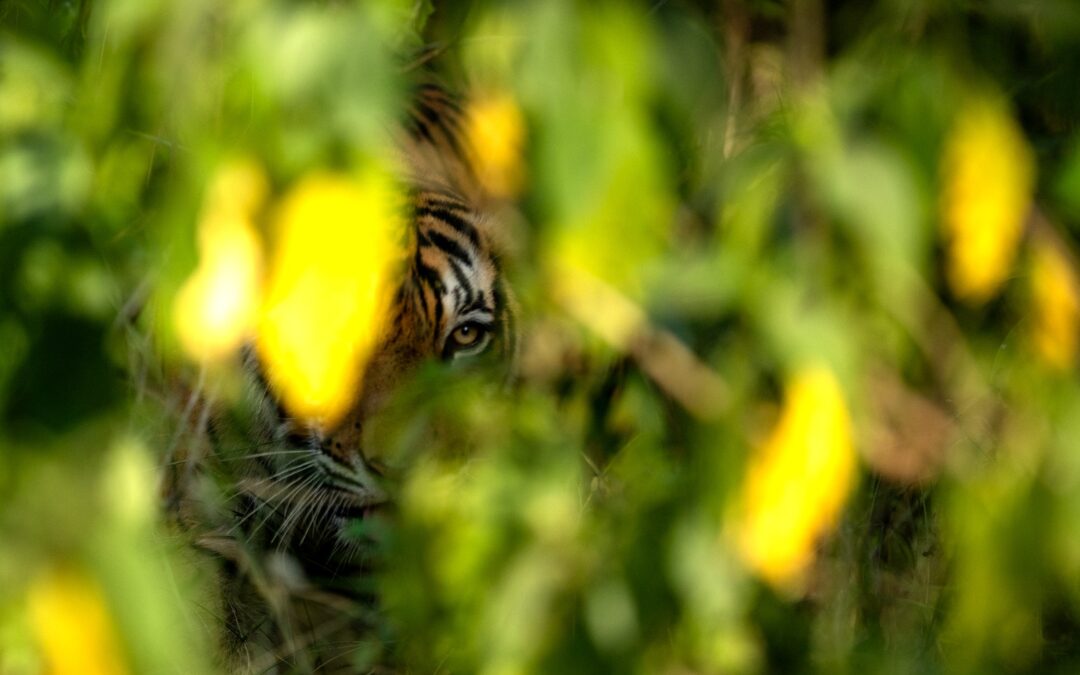Analysis by Dr. Dharmendra Khandal
The Chief Wildlife Warden of Rajasthan recently formed an inquiry committee to investigate the troubling disappearance of 25 tigers from Ranthambhore. Initial findings indicate that the tigers went missing in two phases: 11 were unaccounted for prior to 2024, and an additional 14 disappeared within the past 12 months. Shortly after the investigation began, authorities reported that 10 of these tigers had been located in the field, leaving 15 still missing.
So, what happened to the remaining 15 tigers?
This article examines the profiles and last-known sightings of these missing tigers, based on Tiger Watch’s detailed database, to help shed light on possible reasons for their disappearance.

Tiger Information and Potential Reasons for Disappearance
| # | Tiger ID | Gender | Last Reported | Birth Year | Age (when disappeared) | Possible Cause of Disappearance |
| 1 | T3 | M | 03-08-2022 | 2004 | 18-19 years | Likely deceased due to old age |
| 2 | T13 | F | 17-05-2023 | 2005 | 19-20 years | Likely deceased due to old age |
| 3 | T38 | M | 04-12-2022 | 2008 | 14-15 years | Likely deceased due to old age |
| 4 | T41 | F | 15-06-2024 | 2007 | 17-18 years | Likely deceased due to old age |
| 5 | T48 | F | 12-09-2022 | 2007 | 15-16 years | Likely deceased due to old age |
| 6 | T54 | F | Oct-22 | 2011 | 13-14 years | Possibly sidelined by dominant tiger due to age |
| 7 | T63 | F | Jul-23 | 2011 | 13-14 years | Likely deceased due to age and competition |
| 8 | T74 | M | 14-06-2023 | 2012 | 12-13 years | Possibly displaced by dominant tigers T121 and T112 |
| 9 | T79 | F | 16-06-2023 | 2013 | 11-12 years | Suspicious death; used to live outside the park |
| 10 | T99 | F | 26-07-2024 | 2016 | 9 years | Possible pregnancy complications, previously miscarried in February 2024 |
| 11 | T128 | M | 05-07-2023 | 2020 | 4 years | Likely perished in territorial fights / human conflict |
| 12 | T131 | M | 30-11-2022 | 2019 | 4 years | Likely perished in territorial fights / human conflict |
| 13 | T138 | F | 20-06-2022 | 2020 | 3 years | Likely perished in territorial fights / human conflict |
| 14 | T139 | M | 17-07-2024 | 2021 | 4 years | Likely perished in territorial fights / human conflict |
| 15 | T2401 | M | 04-05-2024 | 2022 | 3 years | Likely perished in territorial fights / human conflict |
Observation and logical assumptions:
The following 15 tigers are currently missing, with possible reasons outlined below:
Aged Tigers:
- Five of these tigers—T3, T13, T38, T41, and T48—are over 15 years old, some reaching as old as 19-20 years.
- Two others, T54 and T63, are 13-14 years old and likely nearing the end of their natural lifespan.
- This tigress T99 experienced pregnancy complications that led to a miscarriage in February 2024. Despite extensive veterinary care, she survived. Recently, there were reports that she might have been pregnant again, though this is unconfirmed. It’s possible similar complications reoccurred, which could explain her current condition.


Photographed taken during the miscarriage
- Tiger T74, at over 12 years old, may have been displaced by dominant tigers T121 and T112, who quickly took over her territory.
- Tigress T79 disappeared under mysterious circumstances, prompting an immediate search by the forest department, which found her two cubs. She primarily lived outside Ranthambhore in the Kanduli area, and her survival in such challenging conditions was remarkable.
- The most significant loss involves five young male tigers, likely due to intense competition with Ranthambhore’s dominant males. In the wild, male tigers face fierce territorial rivalry, often leading to deadly confrontations where only the strongest survive. According to a detailed analysis by the forest department, younger males—such as T128, T131, T139, and T2401—were frequently observed roaming extensively in search of unclaimed territories. Territorial conflicts with established dominant males are a probable cause of their disappearance.
- The disappearance of a female tiger (T138) is a matter of concern, and among the 15 missing tigers, the absence of this sub-adult tigress is particularly worrisome.
In addition to natural rivalry, human-related factors must also be considered. These young males could have fallen victim to conflicts with local communities, including poisoning or other man-made threats. Past incidents, such as the deaths of T114 and her cub and T57, who were poisoned near cattle carcasses, underscore the ongoing risk of human-wildlife conflict. One recent example involves a young male who was displaced by the dominant tigers of Khandar, forcing him to remain on the park’s outskirts as a sub-adult while he seeks a secure territory.
Summary
The disappearance of tigers from Ranthambhore can be attributed to a combination of age, health complications, territorial struggles, and human-related factors. Older tigers, such as T3, T13, T38, T41, and T48, likely succumbed to natural causes due to their advanced age. Tigers typically live up to around 15 years, making survival beyond that age increasingly difficult. While it is remarkable that these tigers survived in Ranthambhore for so long, once they passed the age of 15, they faced immense challenges. Their breeding ceased, and they struggled to maintain their health and territories in the face of mounting competition from younger, dominant tigers.
Tigers like T54, T63, T74, and T79, also in their later years, may have faced significant difficulty in defending their territories from younger, more dominant rivals. As older tigers tend to retreat to the periphery of the park—such as T54, who resided on the outskirts of the Talra range—the chances of conflicts with human populations increase. This was evident in the case of T86, who faced such challenges.
Once the aged female T63, who had previously delivered cubs three times and used to live in the center of the park in the Khandar Valley, was nearly declared dead by the forest officer in the Audi Kho area, the authorities provided her with bait, even stating at one point that she would not survive.
The most significant loss involves four young male and a female tiger —T128, T131, T139, T2401, and T138 —likely victims of territorial conflicts. Male tigers are often engaged in fierce competition for dominance, with only the strongest surviving. According to a detailed analysis by the forest department, these younger males were frequently observed roaming in search of unclaimed territories. Territorial disputes with dominant males could very well be the cause of their disappearance.
However, human-related factors must also be considered. These young males may have been exposed to threats from local communities, such as poisoning or other man-made risks. Previous incidents in the region, such as the poisoning of T114 and her cub, as well as T57 near cattle carcasses, underscore the persistent danger posed by human-wildlife conflict. A recent example includes a young male who was pushed to the park’s outskirts by the dominant tigers of Khandar and is now forced to roam outside the park as a sub-adult, in search of a safe territory.
Finally, Tigress T99, who suffered complications during her pregnancy, may have experienced a recurrence of these issues, potentially accounting for her absence.
This review highlights the urgent need for continued monitoring and proactive measures to address the challenges facing the tiger population in Ranthambhore. By gaining a deeper understanding of these threats, we can develop more effective strategies to mitigate risks and ensure the long-term survival of this iconic species.



There will never be a time when Tigers will not disappear due to age or human animal conflict or interpersonal conflict due to territory. We live in a real world with real issues. The problem with Tiger conservation as with so many other issues is the secrecy with which those entrusted to protect them conduct their affairs and the way policy and monitoring is done with zero accountability. The report provided above by TW should have come from the department. In fact such reports should be a regular feature every time a Tiger goes missing. There should be state of Tigers report in the public domain every 6 months. No officer can ever claim that Tiger deaths will not happen during his watch. However every officer can if he wants display that he is in control and demonstrate this through a transparent process of managing a Park. Sadly the politics, the lack of interest among some officers, the fear of public outcry whenever a Tiger goes missing, the lack of involving private experts to help keeps a shroud of distrust in the Park management among the people at large. We will have to find a solution for monitoring reporting and action taken reporting as a regular task within our system. Tiger conservation Ranthambhore is blessed to have TW and its team of volunteers that we are able to see such a detailed and well explained report on missing Tigers. Maybe it’s time that TW and Forest Department should officially partner in the management of Ranthambhore and its Tigers. I wonder if this can happen / will happen but it’s about time.
As per my 24 year’s working in Ranthambhor national park as a naturalist,I 95percent agree with above conclusion of expert Dharmendra ji Khandal who dedicated his valuable life time in protections of Ranthambhor wildlife specially tigers.
I love Dharmendra khandal articles and information about ranthambore. I would love to know about T-41, my favourite tigress. Please tell me when you saw her last time. Do you think she is alive? if she is not alive then did the forest guard found her dead body? Any trace of her.
I’ve not seen the tigress for quite a few years. T-41 was an aged tigress and is probably dead. Her body, too, was not found.
Thank you for your thorough analysis.
It is apparent that Ranthambore has exceeded its tiger carrying capacity. Consequently, the new tigers being born are facing challenges in securing adequate territory.
T74 is noted as being female, whereas in fact it is a Male (known as “Teddy Bear”. He had a brother, T75 (W Mark) who died after being tranquilised in the midday heat some years ago, and a sister, T73 who also disappeared after I had seen her in 2017. At that time she had two cubs (which I didn’t see)
Thank you for the correction. This was a typing mistake, as I had mentioned it correct in the table.
Thank you for this summary and for your work and dedication relied on by many.
Is there a missing report of the female T-105 also?
Thanks for such a detailed analysis and report on “missing” tigers. Natural area are always dynamic in nature, with such a tiger packed RTR, it’s normal to have old ones disappear and new one to take claim of their territory.
I must congratulate the management of RTR to manage such a high tiger density area and TW mgmt for doing commendable work with locals to keep a keen eye and ear of any mischievous things which is against tiger habitat of RTR.
Great information all villages must be relocated
Thank you for your detailed analysis. Ŵe appreciate your efforts towards saving this beautiful animal.
A well informed and logical analysis… Great…
ST 2303 was in Rewari, a small forest in 800 acres. Where is he now ? Secondly, I hope options to translocate Tigers to other Forests like in Kota ( Raj ), Shivpuri and Guna ( MP ) are being considered !!
यह देखकर बहुत हैरानी होती है कि राज्य में बाघों की ऐसी हालत है और वन्यजीव बोर्ड का कोई भी सदस्य कुछ नहीं बोल रहा है। इनमें से चार सदस्य तो बाघों के बारे में दुनिया भर में जाने जाते हैं।
यह एक बड़ा सवाल है कि आखिर वन्यजीव बोर्ड के सदस्य, खासकर बाघ विशेषज्ञ, इस गंभीर मुद्दे पर चुप क्यों हैं?
ऐसे में लगता है कि वन्यजीव बोर्ड के सदस्य अपनी जिम्मेदारी से भाग रहे हैं।
Very detailed analysis, great efforts tiger watch and khandal sir.
At least someone responcibly gave the detailed report on this mishap.If we can expect this kind of reports straight from forest department, why they hid truth till the day it comes out like a lie?However Tiger watch and Dhram ji are diligently putting truth to people and I hope authorities will soon understand the importance of transparency and accuracy of Tiger count.Better they take assistance of agency like TW for this responcible job.
I visited Ranthambore in June 2019. I saw Krishna and her cubs, T19, T111, T112 and T113 in Zone 4, possibly near high point or somewhere else near the waterhole.
Another young tiger trying to enter into their side from the zone 4 lake side and we can see him from the far. He was patiently waiting and observing and preparing himself for clash.
The guide didn’t know the tiger name or number, but it could be T-95, Although, it could be T-104 as well, but I feel T-95 was trying to make his territory in zone 4 and he was the tiger who was ready to clash with T-19 and her cubs in June 2019.